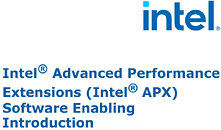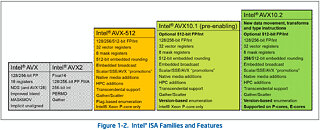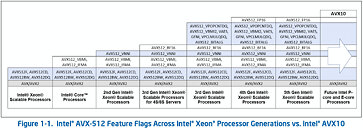T0@st
News Editor
- Joined
- Mar 7, 2023
- Messages
- 3,198 (3.97/day)
- Location
- South East, UK
| System Name | The TPU Typewriter |
|---|---|
| Processor | AMD Ryzen 5 5600 (non-X) |
| Motherboard | GIGABYTE B550M DS3H Micro ATX |
| Cooling | DeepCool AS500 |
| Memory | Kingston Fury Renegade RGB 32 GB (2 x 16 GB) DDR4-3600 CL16 |
| Video Card(s) | PowerColor Radeon RX 7800 XT 16 GB Hellhound OC |
| Storage | Samsung 980 Pro 1 TB M.2-2280 PCIe 4.0 X4 NVME SSD |
| Display(s) | Lenovo Legion Y27q-20 27" QHD IPS monitor |
| Case | GameMax Spark M-ATX (re-badged Jonsbo D30) |
| Audio Device(s) | FiiO K7 Desktop DAC/Amp + Philips Fidelio X3 headphones, or ARTTI T10 Planar IEMs |
| Power Supply | ADATA XPG CORE Reactor 650 W 80+ Gold ATX |
| Mouse | Roccat Kone Pro Air |
| Keyboard | Cooler Master MasterKeys Pro L |
| Software | Windows 10 64-bit Home Edition |
Intel has published a preview article covering its new AVX10 ISA (Instruction Set Architecture)—the announcement reveals that both P-Cores & E-Cores (on next-gen processors) will be getting support for AVX-512. Team Blue stated: "Intel AVX10 represents a major shift to supporting a high-performance vector ISA across future Intel processors. It allows the developer to maintain a single code-path that achieves high performance across all Intel platforms with the minimum of overhead checking for feature support. Future development of the Intel AVX10 ISA will continue to provide a rich, flexible, and consistent environment that optimally supports both Server and Client products."
Due to technical issues (E-core related), Intel decided to disable AVX-512 for Alder Lake and Raptor Lake client-oriented CPU lineups. AMD has recently adopted the fairly new instruction set for its Ryzen 7040 mobile series, so it is no wonder that Team Blue is attempting to reintroduce it in the near future—AVX-512 was last seen working properly on Rocket and Tiger Lake chips. AVX10 implementation is expected to debut with Granite Rapids (according to Longhorn), and VideoCardz reckons that Intel will get advanced instructions for Efficiency cores working with its Clearwater Forest CPU architecture.



View at TechPowerUp Main Site | Source
Due to technical issues (E-core related), Intel decided to disable AVX-512 for Alder Lake and Raptor Lake client-oriented CPU lineups. AMD has recently adopted the fairly new instruction set for its Ryzen 7040 mobile series, so it is no wonder that Team Blue is attempting to reintroduce it in the near future—AVX-512 was last seen working properly on Rocket and Tiger Lake chips. AVX10 implementation is expected to debut with Granite Rapids (according to Longhorn), and VideoCardz reckons that Intel will get advanced instructions for Efficiency cores working with its Clearwater Forest CPU architecture.



View at TechPowerUp Main Site | Source





